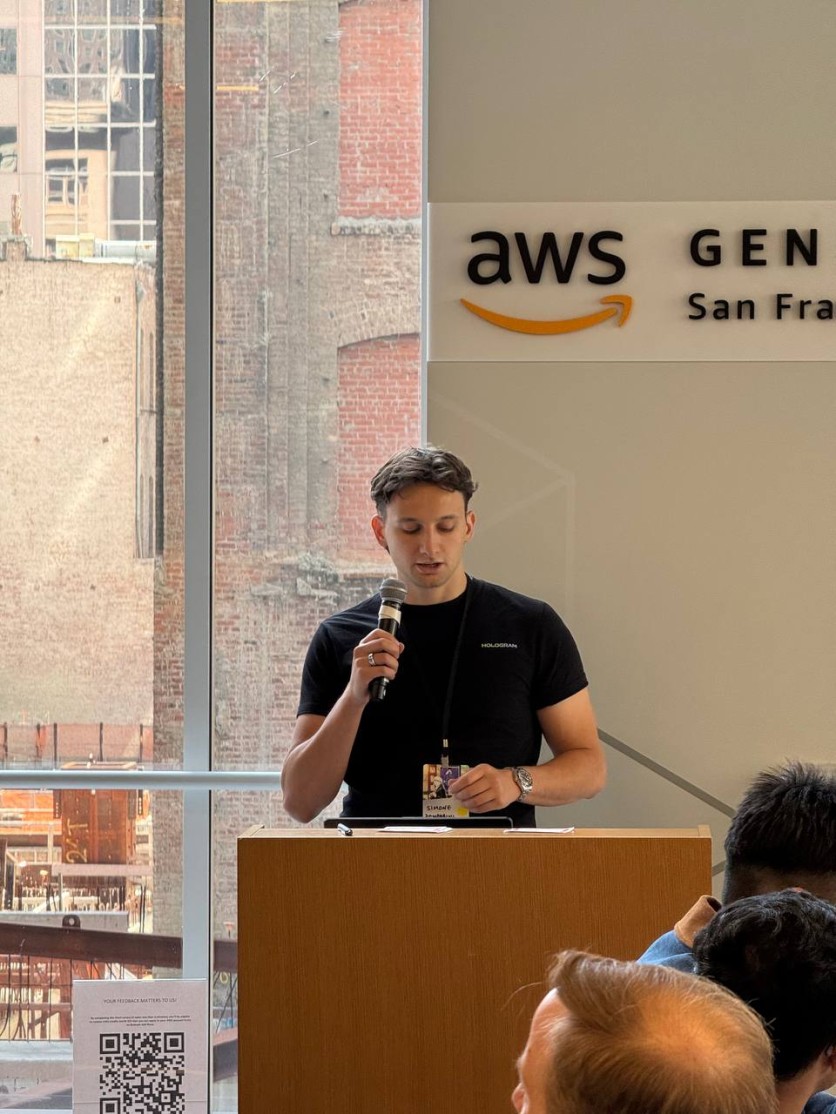
Artificial intelligence took an evolutionary leap forward with content generation tools like ChatGPT. But until now, they've remained fundamentally limited, unable to take independent action like an actual assistant. With the advent and refinement of agentic AI, they're taking a significant step toward being autonomous systems that can plan, decide, and execute tasks without human intervention.
Simone Zamparini is helping to drive this evolution, leveraging his background in computational mathematics to build a thriving career in scalable AI agent infrastructure.
As a senior software engineer at Hologram Labs, he's leveraging cutting-edge AI frameworks and building agents that can act entirely on their own to create content and interact with social media followers.
From Virtual Reality to AI Agent Infrastructure
Early in his career, Zamparini earned his chops as a software engineer by creating OpenLabVR—a virtual reality environment that would allow students to interact with virtual biology and chemistry labs using Meta hand-tracking technology.

This early success gave Zamparini the confidence in his ability to build complex systems with emerging technologies. It's work that directly led to his current career at Hologram Labs, where he's now building systems that power AI characters and agents that serve more than 1 million users.
Designing a New Digital Intelligence System for True Agent Autonomy
Among Zamparini's contributions to Hologram Labs, AVA stands out above the rest. Building on the startup's core offering of digital character and avatar development, AVA is a fully autonomous AI agent that can run an entire social media presence on behalf of its user.
"We designed a novel multi-agent architecture that lets users fully automate their social media accounts with just one click," he explains. "Each AI agent has two core components: a ReAct (reasoning and acting) agent responsible for daily planning and strategy, and a ReWoo (reasoning without observation) agent tasked with executing those plans in the real world."
Put simply, ReAct puts the content strategy together and ReWoo executes it, generating posts and short-form videos while replying to and engaging with users autonomously.
Shortly after its launch, AVA powered 1,000 Twitter accounts that reached more than 35,000 followers and generated more than 10 million impressions. Each account now operates as a fully automated and independent digital persona, helping content creators scale their social media presence without having to lift a finger.
MCP and LangChain: The Frameworks Behind AVA
To make these agents work, Zamparini is relying on cutting-edge AI frameworks that turn generative AI into more than just a chatbot:
The first is the model context protocol (MCP).
While most modern AI tools are good at tasks like generating text, they can't take real-world actions on their own when those actions require input from other systems. For example, ChatGPT can't pull up your calendar or post on social media because it doesn't have access to those systems or their data.
The MCP framework changes that serve as an intermediary between the AI agent and other apps to get information, make decisions, and take real action.
This is the technology that makes AVA work. Zamparini built a custom multi-server MCP client as a framework to help his autonomous agents interact across systems. This way, agents can figure out which tools they need, make requests on the fly, and work across different platforms in real time. Better yet, the agents can remember past and cross-platform context and make better decisions as a result.
It's a big step toward a future where AI enables digital autonomy, connecting a wide range of systems and applications into one ecosystem.
The other piece of the puzzle is the LangChain framework, which allows AVA agents to perform repetitive actions at scale while using context and memory to maintain a consistent personality over time.
Like the rest of his AVA build, LangChain works as a modular concept with pre-packaged components that can easily scale across more agents or functionality. And because Zamparini's design is modular, every new feature can be reused or scaled up easily. New tools can be developed quickly and without breaking what already works, enhancing rapid experimentation without sacrificing reliability or performance.
Working Toward Seamless AI Interaction

While Zamparini is dedicated to making AVA the best it can be, he's already thinking about the next generation of AI and VR.
"I see a unique opportunity to merge these worlds," he says. "I believe the future lies in seamless experiences, where smart glasses and wearable devices intersect with highly personalized AI models to assist, inform, and inspire us in real time."
In that future, smart glasses and voice interfaces could turn any VR environment into a hyperpersonalized, interactive, immersive space. The same agents that now write tweets and create videos could soon summarize meetings, whisper context, or even create the VR worlds in which the students of tomorrow learn practical skills.
It's cross-system functionality at its finest, empowering users around the world through fully personalized AI companions.
ⓒ 2025 TECHTIMES.com All rights reserved. Do not reproduce without permission.




